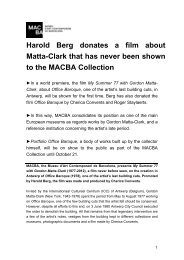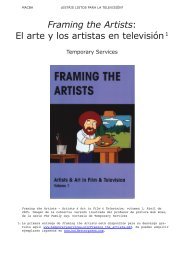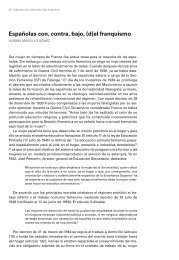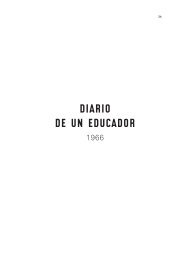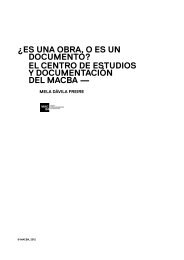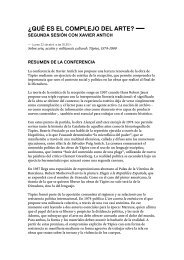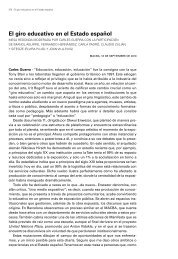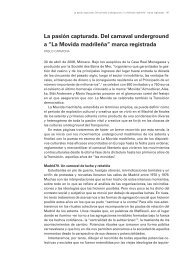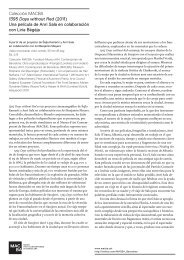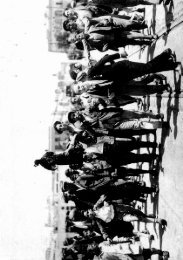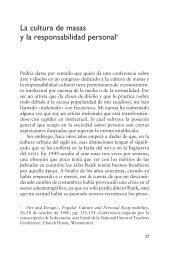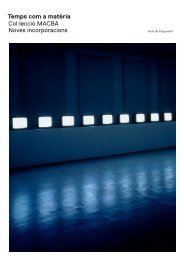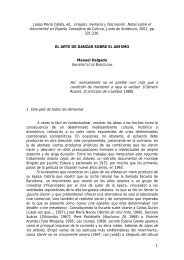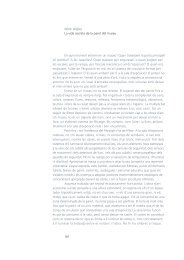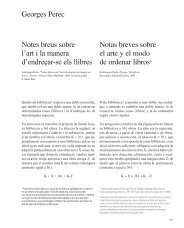Chance, Indeterminacy, Multiplicity - Macba
Chance, Indeterminacy, Multiplicity - Macba
Chance, Indeterminacy, Multiplicity - Macba
You also want an ePaper? Increase the reach of your titles
YUMPU automatically turns print PDFs into web optimized ePapers that Google loves.
3. Harold Rosenberg, “The American<br />
Action Painters” (1952), The Tradition<br />
of the New, New York: McGraw-Hill,<br />
1959, pp. 23–39. Kaprow’s interest in<br />
Abstract Expressionism is, of course,<br />
manifest in “The Legacy of Jackson<br />
Pollock” (1958), in Kelley, (ed.), pp. 1–9.<br />
4. Allan Kaprow, “One Chapter from<br />
‘The Principles of Modern Art’,” It Is<br />
No. 4, 1958, p. 52, ellipses in original.<br />
On Cage’s critique of inspiration, see,<br />
for example, John Cage, “45’ for a<br />
Speaker” (1954), Silence, Middletown,<br />
Conn.: Wesleyan University Press,<br />
1961, p. 170.<br />
5. Allan Kaprow, Assemblage, Environments,<br />
and Happenings, New York:<br />
Harry N. Abrams, 1966, p. 175. Kaprow’s<br />
move away from Cage is discussed in<br />
Jeff Kelley, Childsplay: The Art of Allan<br />
Kaprow, Berkeley, Ca.: University of<br />
California Press, 2004, pp. 20–46.<br />
6. Al Hansen’s attraction to Cage’s<br />
sense of anarchy is mentioned in<br />
Dick Higgins, “Postface,” Jefferson’s<br />
Birthday/Postface, New York: Something<br />
Else, 1964, pp. 49, 51. The notion of<br />
anarchy would also be mentioned by<br />
Kaprow in notes to “A program<br />
of Happenings? Events! & Situations?<br />
Directed by Al Hansen, an eclectic,”<br />
(May 2, 1960), repr. in Hermann Braun,<br />
(ed.), George Brecht, Notebook V<br />
(March 1960-November 1960), Cologne:<br />
Walther König, 1997, p. 88. On Hansen’s<br />
Hall Street Happening, see Al Hansen,<br />
A Primer on Happenings and Time/<br />
Space Art, New York: Something Else<br />
Press, 1965, pp. 11–20.<br />
7. Higgins, “Postface,” pp. 50–51;<br />
Barbara Rose, An Interview with Robert<br />
Rauschenberg, New York: Vintage<br />
Books, 1987, p. 34.<br />
8. Dick Higgins, “Boredom and Danger”<br />
(1966), A Dialectic of Centuries: Notes<br />
towards a Theory of the New Arts, New<br />
York: Printed Editions, 1978, pp. 48–49.<br />
Kaprow not dissimilarly links chance<br />
to “risk and fear” in “Happenings in<br />
the New York Scene,” p. 19. Higgins’s<br />
Danger Music #17 recalls Tristan<br />
Tzara’s “Roar,” in Robert Motherwell,<br />
(ed.), The Dada Painters and Poets:<br />
An Anthology, New York: Wittenborn,<br />
Schultz, Inc., 1951, p. 96; Tzara’s “poem”<br />
was included as part of Hansen’s Hall<br />
Street Happening, see Hansen, A Primer,<br />
pp. 18–19.<br />
Kaprow, for instance, derived much from his introduction to Cage,<br />
he largely rejected the strictness with which Cage implemented<br />
chance operations in favor of intuition and an understanding of the<br />
Abstract Expressionist legacy akin to its almost existentialist reception<br />
by art critic Harold Rosenberg. 3 Aspects of Kaprow’s resistance<br />
to the Cagean paradigm can be traced as far back as 1958, when he<br />
explained that “the freest, most spontaneous and (to this writer)<br />
most enjoyable” approach he had yet adopted in the development<br />
of his happenings was “just begin[ning] to imagine things, writing<br />
down his parts as he goes along until he decides to stop.” Reciting<br />
(and then rejecting) Cage’s already established critique of any such<br />
intuitive and improvisational procedure, Kaprow continued, “when<br />
one is left to intuition the risk is great that one becomes too dependent<br />
on ‘inspiration’ (an extremely unreliable mistress) and so falls<br />
into the trap of coming up constantly with clichés and habits. But<br />
then, sometimes one is lucky….” 4 By 1966, Kaprow would come<br />
to reject Cage’s engagement with chance operations in favor of an<br />
approach he called “change,” predicated on “the following of<br />
intuition and wisdom” and “dependent upon human experience.” 5<br />
Like Kaprow, fellow New School classmates and future happeners<br />
Al Hansen and Dick Higgins would adhere to something of an<br />
existential vision of authorial risk, taking a Rosenberg-like conception<br />
of action painting into what could be called action music or<br />
action theater. Hansen, for instance, embraced the anarchic side<br />
of Cage’s project, which he also took in a partially anti-Cagean<br />
direction of improvisation within chaotic and collaborative pieces<br />
like his Hall Street Happening (1961; which inadvertently involved<br />
a performer’s falling through a skylight). 6 Higgins credited Cage’s<br />
course with providing “a sense of general activity and a taste for my<br />
own direction, to which previously my own skepticism had been<br />
very unkind,” an observation not unlike that made by Cage’s longtime<br />
artistic colleague, Robert Rauschenberg, who called Cage “the<br />
only one who gave me permission to continue my own thoughts.” 7<br />
Higgins, however, declared himself at odds with much of Cage’s<br />
perspective. Moving in his own direction, Higgins transformed<br />
Cage’s interest in chance – which, in French, as Higgins pointed<br />
out, is “hasard” – into the notion of hazard or, more precisely,<br />
danger, which he explored in numerous compositions such<br />
as Danger Music No. 17 (1962), the score for which reads simply,<br />
“Scream! Scream! Scream! Scream! Scream! Scream!” 8<br />
According to Higgins, neither he nor Hansen had much patience for<br />
the more detailed articles about chance operations and indeterminacy<br />
Cage explicated within the course. “Once or twice,” he noted:<br />
211



